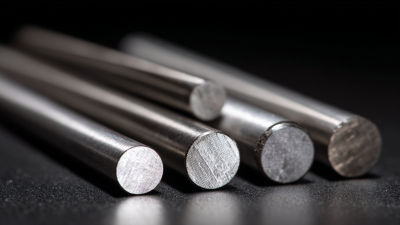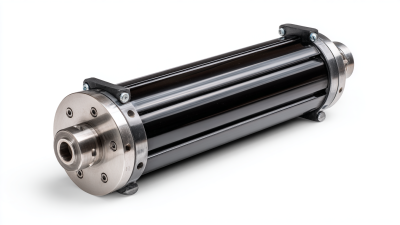Exploring the Versatility of Alumina Ceramic Rings in Modern Technology Applications
Table of Contents
- Understanding the Composition and Properties of Alumina Ceramic Rings for Industrial Use
- Analyzing the Manufacturing Processes of Alumina Ceramic Rings in Advanced Technologies
- Examining the Applications of Alumina Ceramic Rings in Electronics and Semiconductor Industries
- Assessing the Role of Alumina Ceramic Rings in Aerospace and High-Temperature Environments
- Evaluating the Cost-Effectiveness and Longevity of Alumina Ceramic Rings in Modern Applications
- FAQS
- Conclusion
- Related Posts
Alumina Ceramic Rings have emerged as pivotal components in various modern technology applications, owing to their remarkable properties such as high wear resistance, low thermal conductivity, and exceptional mechanical strength. According to a recent market analysis by Research and Markets, the global ceramics market is projected to reach $471 billion by 2024, driven by the increasing adoption of alumina ceramic materials across industries such as electronics, automotive, and medical technology. ST.CERA CO., LTD., a leading private high-tech enterprise specializing in precision ceramic manufacturing, leverages a team of top-ranking experts to innovate and produce high-quality Alumina Ceramic Rings that meet the evolving demands of these sectors. Our commitment to research and development, coupled with our advanced manufacturing capabilities, positions us at the forefront of the ceramic industry, enabling us to deliver precision ceramic parts that enhance performance and efficiency in modern technological applications.

Understanding the Composition and Properties of Alumina Ceramic Rings for Industrial Use
Alumina ceramic rings are notable for their exceptional properties, making them indispensable in various industrial applications. Composed predominantly of aluminum oxide (Al2O3), these ceramics exhibit remarkable hardness and wear resistance, allowing them to withstand harsh environments. According to a 2022 report from Markets and Markets, the global demand for alumina ceramics is projected to reach $12.9 billion by 2026, driven by their applications in electronics, automotive, and aerospace industries. Their dielectric strength and thermal stability further enhance their desirability, particularly in electrical insulation and thermal management systems.
The composition of alumina ceramic rings typically varies, with purity levels ranging from 85% to 99.9% Al2O3. Higher purity alumina exhibits not only superior mechanical strength but also enhanced chemical resistance. A 2021 study published in the Journal of Ceramic Science highlighted that alumina ceramics with 99.5% purity demonstrated a flexural strength of 400 MPa and an impressively high service temperature up to 1750°C. This versatility in composition allows manufacturers to tailor properties for specific applications, such as in wear-resistant components, cutting tools, and high-performance insulators, thus reinforcing the integral role of alumina ceramic rings in modern technology.

Analyzing the Manufacturing Processes of Alumina Ceramic Rings in Advanced Technologies
Alumina ceramic rings have gained significant traction in advanced technology applications due to their exceptional properties, including high strength, thermal stability, and resistance to wear and corrosion. The manufacturing processes for these ceramic components are highly specialized and typically involve techniques such as slip casting, extrusion, and isostatic pressing. According to a report by MarketsandMarkets, the global alumina ceramics market is projected to reach USD 3.17 billion by 2024, driven by the rising demand in industries such as electronics, telecommunications, and medical devices.
Efficient manufacturing of alumina ceramic rings requires careful control of raw material purity and processing conditions. Techniques like hot pressing and sintering are common, as they enhance the material's density and mechanical properties. The importance of quality control during production cannot be overstated; research indicates that defects in ceramic components can lead to significant failures in high-stress applications. Therefore, investing in advanced manufacturing technologies is paramount for achieving optimal performance in end products.
Tips: When considering the integration of alumina ceramic rings into your project, ensure to collaborate with manufacturers who prioritize stringent quality controls and have expertise in advanced fabrication techniques. Additionally, perform a thorough analysis of your application requirements to select the appropriate alumina grade tailored for specific performance metrics.
Exploring the Versatility of Alumina Ceramic Rings in Modern Technology Applications
Examining the Applications of Alumina Ceramic Rings in Electronics and Semiconductor Industries
Alumina ceramic rings serve a crucial role in the electronics and semiconductor industries, providing an array of benefits that enhance performance and reliability. These materials are valued for their excellent thermal conductivity and mechanical strength, making them ideal for various applications, including thermal management systems and insulating components. As the global semiconductor ceramic consumable parts market expands, projected to reach approximately USD 3.39 billion by 2033, the demand for high-quality ceramic parts will continue to grow, particularly in advanced semiconductor fabrication processes.
Recent trends highlight the importance of microfluidics and thermal interface materials (TIMs) in semiconductor manufacturing. Alumina ceramic rings are increasingly used in these areas due to their ability to withstand extreme temperatures and chemical exposure, while also providing efficient heat dissipation. This versatility not only contributes to improved thermal management but also supports the miniaturization of semiconductor devices, aligning with industry needs for compact and efficient electronic components. As technology advances, the applications of alumina ceramic rings are likely to expand further, solidifying their position as a vital component in modern electronics and semiconductor sectors.
Assessing the Role of Alumina Ceramic Rings in Aerospace and High-Temperature Environments
Alumina ceramic rings are emerging as vital components in aerospace technology, particularly in high-temperature environments where other materials may fail. The unique properties of alumina ceramics, such as their high thermal stability, excellent wear resistance, and ability to withstand significant thermal stress, make them ideal for applications ranging from satellite components to advanced optical systems used in both rail and space industries. Recent research has highlighted the critical role these materials play in ensuring the reliability of aerospace optical cables, which must endure extreme conditions while maintaining performance integrity.
The thermal stress simulations conducted in recent studies reveal that alumina ceramic rings can significantly enhance the durability and efficiency of aerospace systems. These simulations help predict how these rings will react under varying temperature gradients and mechanical loads, ensuring that they provide optimal performance in demanding environments. As technology continues to evolve, the integration of alumina ceramic rings in aerospace applications may pave the way for advancements in design and materials science, further pushing the boundaries of what is possible in high-temperature and high-stress scenarios.

Evaluating the Cost-Effectiveness and Longevity of Alumina Ceramic Rings in Modern Applications
Alumina ceramic rings have emerged as a significant component in various modern technology applications, primarily due to their impressive cost-effectiveness and longevity. These rings offer a perfect balance between performance and affordability, making them ideal for demanding environments. For instance, in sectors such as aerospace and electronics, where durability is crucial, alumina ceramics serve as reliable materials that can withstand extreme temperatures and corrosive conditions. Their exceptional wear resistance significantly reduces maintenance costs over time, which is a key advantage for industries looking to enhance their operational efficiency.
**Tips**: When choosing alumina ceramic rings, consider the specific application requirements. Assess the temperature range and potential exposure to chemicals, as these factors will influence the longevity and performance of the rings. It’s also beneficial to compare different suppliers to find the best combination of quality and cost.
Another consideration is the design of the rings. Customized shapes can optimize their functionality in various applications, from precision instruments to protective casings. Evaluating the life cycle cost against initial investment can help in making informed decisions, ultimately leading to superior performance while managing budgets effectively.
Exploring the Versatility of Alumina Ceramic Rings in Modern Technology Applications - Evaluating the Cost-Effectiveness and Longevity of Alumina Ceramic Rings in Modern Applications
| Application | Cost per Unit | Longevity (Years) | Temperature Resistance (°C) | Advantages |
|---|---|---|---|---|
| Electrical Insulation | $2.00 | 10 | 1500 | High dielectric strength, low thermal conductivity |
| Wear Resistance | $3.50 | 12 | 1200 | Exceptional hardness, low friction |
| Thermal Barrier Coating | $4.00 | 15 | 1400 | Excellent thermal insulation, lightweight |
| Chemical Resistance | $5.00 | 20 | Unknown | Inert to most chemicals, long service life |
FAQS
: Alumina ceramic rings are known for their exceptional properties, including high strength, thermal stability, and resistance to wear and corrosion.
Common manufacturing techniques for alumina ceramic rings include slip casting, extrusion, hot pressing, and isostatic pressing followed by sintering, which enhances their density and mechanical properties.
The demand for alumina ceramics is increasing in industries such as electronics, telecommunications, and medical devices.
Quality control is crucial because defects in ceramic components can lead to significant failures in high-stress applications, impacting performance and reliability.
They enhance performance and reliability in thermal management systems and insulating components, while also withstanding extreme temperatures and chemical exposure.
The global semiconductor ceramic consumable parts market is projected to reach approximately USD 3.39 billion by 2033, indicating a growing demand for high-quality ceramic parts, including alumina rings.
Alumina ceramic rings are used in aerospace technology for high-temperature applications, including satellite components and advanced optical systems, due to their thermal stability and wear resistance.
Research has shown that alumina ceramic rings can enhance the durability and efficiency of aerospace systems under thermal stress, ensuring reliability in extreme conditions.
Their thermal conductivity and ability to dissipate heat efficiently make alumina ceramic rings ideal for compact and efficient electronic components in semiconductor manufacturing.
It’s important to collaborate with manufacturers who prioritize stringent quality controls and have expertise in advanced fabrication techniques, as well as analyze application requirements to select the appropriate alumina grade.
Conclusion
The article "Exploring the Versatility of Alumina Ceramic Rings in Modern Technology Applications" delves into the crucial role of Alumina Ceramic Rings in various industries. It begins by detailing the composition and properties that make these rings ideal for industrial use, highlighting their durability, chemical resistance, and electrical insulating capabilities. The manufacturing processes are analyzed, emphasizing advanced techniques that ensure precision and quality.
Furthermore, the article explores the diverse applications of Alumina Ceramic Rings, particularly in the electronics and semiconductor industries, where they enhance performance and reliability. It also assesses their significance in aerospace and high-temperature environments, showcasing their ability to withstand extreme conditions. Finally, the evaluation of cost-effectiveness and longevity underscores the value of Alumina Ceramic Rings in modern applications, particularly for companies like St.Cera Co., Ltd., which specializes in precision ceramic manufacturing, ensuring high standards and innovations in the field.
Related Posts
-

7 Best Ceramic Lift Pins for Enhanced Performance in Manufacturing
-

How to Maximize Performance with a Ceramic Capture Ring in Your Processes
-

The Science Behind Ceramic Rods: Unveiling Their Role in Modern Technology
-

Ultimate Checklist for Sourcing the Best Beo Ceramic Tube for Your Business Needs
-

Unlocking Efficiency: How Vacuum End Effectors Revolutionize Robotics and Automation
-

How to Choose the Right Alumina Ceramic Roller for Your Industrial Needs
Blog Tags:

